De quel matériau est-il fait des pantalons de yoga?
Le choix du mauvais pantalon de yoga peut entraîner une gêne, des problèmes de transparence embarrassants ou une usure prématurée. La différence entre une pratique agréable et une distrante se résume souvent à la sélection des tissus.
La plupart des pantalons de yoga sont fabriqués à partir de mélanges synthétiques contenant du polyester et du spandex (élastique), généralement dans un rapport 80-20. Les options premium peuvent incorporer du nylon pour la durabilité ou des tissus de performance spécialisés comme le lycra® spandex. Les mélanges de coton existent mais sont moins courants pour l'usure du yoga.
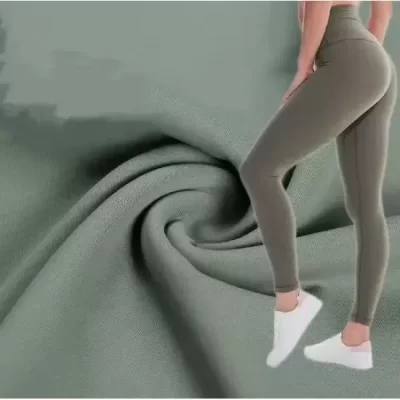
Lorsque j'ai commencé à fabriquer un pantalon de yoga pour les marques internationales, j'ai été surpris par la complexité technique derrière ces vêtements apparemment simples. La bonne combinaison de matériaux peut avoir un impact considérable, de la gestion de l'humidité à la durabilité et au prix. Explorons ce qui se passe vraiment dans la création du tissu de pantalon de yoga parfait.
De quel matériau les pantalons de yoga doivent-ils être fabriqués ?
La sélection des pantalons de yoga se sent souvent accablants avec d'innombrables options de tissu et termes techniques. Sans comprendre les principes fondamentaux, vous risquez d'investir dans un pantalon qui s'étend, s'étend ou de devenir transparent pendant les poses.
Le matériau idéal pour un pantalon de yoga dépend de votre style de pratique. Pour le yoga chaud et les séances intenses, les mélanges synthétiques contenant 75 à 85 % de polyester ou de nylon et 15 à 25 % d'élasthanne offrent une évacuation de l'humidité et une élasticité optimales. Pour un yoga doux, les mélanges de coton (50 à 60 % de coton avec des matières synthétiques) offrent respirabilité et confort.
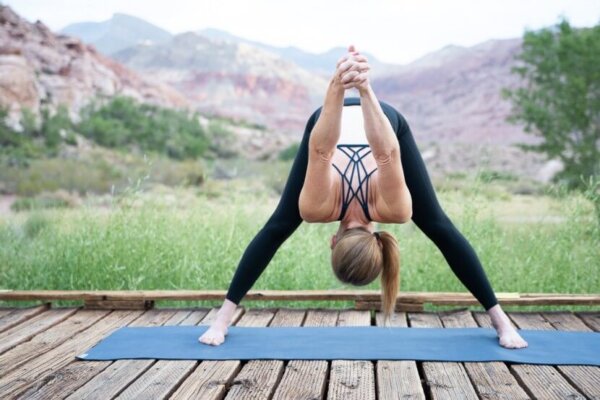
J'ai travaillé avec des dizaines de marques de vêtements de yoga pour développer leurs formulations de tissu parfaites, et j'ai appris que la sélection des matériaux est à la fois la science et l'art. Le tissu doit se produire techniquement tout en livrant l'esthétique et le confort.
Les composants principaux des tissus de pantalons de yoga apportent chacun des avantages spécifiques:
Matériaux principaux des pantalons de yoga et leurs propriétés
| Matériel | Avantages | Limites | Meilleur pour |
|---|---|---|---|
| Polyester | Wicking, durable, conserve la forme | Moins respirant, rétention potentielle des odeurs | Yoga à haute intensité, yoga chaud |
| Nylon | Sensation douce, durabilité, légère brillance | Coût plus élevé, absorbe l'humidité | Pantalon de yoga premium, vêtements quotidiens |
| Spandex / élastique | Étirement à 4 voies, rétention de forme | Se détériore avec la chaleur, il faut du mélange | Tous les styles de yoga (en tant que composant Blend) |
| LYCRA® (Spandex premium) | Récupération d'étirement supérieure, durabilité | Coût plus élevé, Brand Premium | Performance Yoga Wear, marques haut de gamme |
| Coton | Respirabilité, douceur, sensation naturelle | Absorbe l'humidité, s'étend | Yoga doux, vêtements de salon |
La méthode de construction compte autant que le matériau lui-même. La plupart des pantalons de yoga haut de gamme utilisent des coutures entrecroisées qui permettent au tissu de s'étirer dans plusieurs directions sans que les coutures ne se cassent. De plus, la structure du tricot joue un rôle crucial : le tricot circulaire crée une expérience sans couture tandis que le tricot chaîne offre une meilleure structure et une meilleure compression.
Le poids du tissu est un autre facteur crucial souvent négligé par les consommateurs. Dans notre production, nous utilisons généralement des tissus allant de 230 à 320 GSM (grammes par mètre carré) pour les pantalons de yoga. Les tissus plus légers (230-260 GSM) offrent une meilleure respirabilité mais peuvent compromettre l'opacité, tandis que les tissus plus lourds (280-320 GSM) offrent une meilleure couverture mais peuvent paraître plus chauds pendant la pratique.
Pour les avantages de la compression et de la mise en forme, certains pantalons de yoga intègrent un pourcentage plus élevé d'élastane ou de structures en tricot spécifiquement conçues. Ces aspects techniques ne sont pas toujours mis en évidence dans le matériel marketing mais font une différence significative dans les performances. Les marques premium développent souvent des mélanges de tissus propriétaires avec des propriétés techniques spécifiques adaptées à différents styles de yoga.
Les pantalons de yoga sont-ils en coton ?
De nombreux yogis se demandent si le coton traditionnel convient à la pratique du yoga. Avec des informations contradictoires des marques et des influenceurs, il est facile de se sentir confus quant à savoir si les pantalons de yoga en coton sont un choix pratique ou un compromis de confort.
While pure cotton yoga pants exist, they represent a small minority of the market. Most "cotton" Les pantalons de yoga ne contiennent en réalité que 50 à 60 % de coton mélangé à des fibres synthétiques comme le polyester et l'élasthanne. Le pur coton ne possède pas l'élasticité et la gestion de l'humidité nécessaires à la plupart des pratiques de yoga modernes.
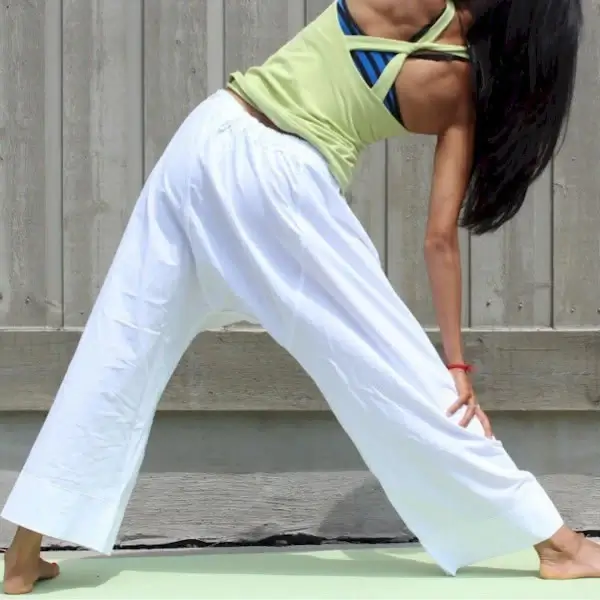
When I first started producing yoga wear, I worked with a brand that insisted on high cotton content for their "natural" positionnement. Nous avons rapidement découvert que tout ce qui contenait plus de 60 % de coton créait de sérieux problèmes de performance : le pantalon s'étirait pendant l'entraînement et ne récupérait pas, devenait lourd de sueur et perdait sa forme après le lavage.
Le coton offre de véritables avantages dans les vêtements de yoga. Il est respirant, hypoallergénique et donne une sensation naturelle que certains praticiens préfèrent, en particulier pour des pratiques plus douces comme le yoga réparateur. La texture douce rend les mélanges de coton particulièrement confortables pour se prélasser avant et après l'entraînement.
Cependant, les limites du coton deviennent apparentes lors de séances de yoga plus actives:
Comparaison des performances des mélanges de coton et de mélanges synthétiques
| Facteur de performance | Teneur en coton élevé (70% +) | Mélange de coton modéré (30-50%) | Mélange synthétique (0-10% de coton) |
|---|---|---|---|
| Gestion de l'humidité | Pauvre - absorbe et conserve l'humidité | Modéré - une certaine capacité de mèche | Excellent - évoque activement l'humidité |
| Rétention de forme | Pauvre - s'étend avec une utilisation | Bon - se rétablit avec un ensemble | Excellent - maintient la forme au fil du temps |
| Durabilité | Modéré - le tissu s'use mais peut moins piluler | Bon - durabilité équilibrée | Excellent - résistant à l'usure et au lavage |
| Respirabilité | Excellent - circulation de l'air naturel | Très bien - maintient une certaine respirabilité | Modéré à bon - dépend de la construction |
| Opacité lorsqu'elle est étirée | Pauvre à modéré - devient souvent transparent | Bon - équilibre de couverture et d'étirement | Excellent - maintient la couverture dans toutes les positions |
La teneur en coton dans les pantalons de yoga a diminué régulièrement au cours de la dernière décennie à mesure que les attentes de performance ont augmenté. Dans notre usine de fabrication, moins de 15% des pantalons de yoga que nous produisons contiennent maintenant n'importe quel coton. Les exceptions sont généralement destinées aux lignes de vêtements de salon ou à des produits spécialisés ciblant des préférences de clients spécifiques pour les fibres naturelles.
Pour les consommateurs qui recherchent spécifiquement un pantalon de yoga en coton, la recherche de mélanges avec une teneur en coton de 40 à 50% représente généralement le meilleur compromis entre le confort naturel et les performances techniques. Ces mélanges se sentiront plus semblables à un coton tout en conservant suffisamment de contenu synthétique pour fournir l'étirement nécessaire et une gestion d'humidité raisonnable.
Certaines marques innovantes incorporent désormais des alternatives de coton ou de coton biologiques comme Modal (Beech Tree Fibre) et le bambou dans leur pantalon de yoga. Ces matériaux offrent une partie de la respirabilité du coton et une sensation douce avec des caractéristiques de performance améliorées, bien qu'elles nécessitent toujours du mélange avec des fibres synthétiques pour obtenir un étirement et une récupération optimaux.
Quel est le matériau du pantalon de yoga Lululemon ?
Lululemon a révolutionné des vêtements de yoga avec leurs tissus propriétaires, créant une référence que d'autres marques essaient souvent de faire correspondre. Comprendre ce qui se passe dans ces produits premium aide à éclairer de meilleures décisions d'achat à tous les prix.
Lululemon's signature yoga pants are made from their proprietary "Luon" fabric, which is primarily a nylon-lycra blend (approximately 86% nylon, 14% Lycra® spandex). Other Lululemon proprietary fabrics include Luxtreme (a smoother, more compression-focused nylon blend) and Nulu (a buttery-soft, lighter-weight blend used in their "Align" pantalon).
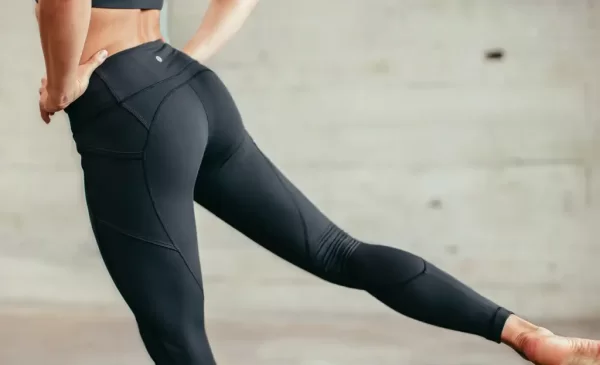
Travailler avec des marques de vêtements de sport haut de gamme m'a donné un aperçu de ce qui distingue les matériaux de Lululemon. Alors que de nombreuses entreprises tentent de créer des tissus similaires, plusieurs facteurs contribuent aux propriétés uniques des matériaux Lululemon.
La première différence clé est leur utilisation de Lycra® spandex de haute qualité plutôt que d'élasthanne ou de spandex générique. Dans notre usine de production, nous faisons la distinction entre le spandex standard et le spandex Lycra® haut de gamme, ce dernier coûtant beaucoup plus cher mais offrant une récupération d'étirement et une longévité supérieures. Cela permet aux pantalons Lululemon de conserver leur forme malgré des centaines de cycles d'usure et de lavage.
Les tissus principaux de Lululemon se décomposent en plusieurs mélanges exclusifs :
Technologies de tissus primaires de Lululemon
| Nom du tissu | Composition primaire | Propriétés clés | Meilleur pour |
|---|---|---|---|
| Luon | ~86 % nylon, 14 % Lycra | Sensation semblable à celle du coton, extensible dans quatre sens, évacuant l'humidité | Yoga en studio, à porter au quotidien |
| Luxtreme | ~69 % nylon, 31 % Lycra | Sensation plus douce, compression, haute durabilité | Entraînements de haute intensité, course à pied |
| Zéro | ~81 % nylon, 19 % Lycra | Ultra-soft "naked" sensation, lightweight | Yoga doux, pratique axée sur le confort |
| Everlux | ~77 % nylon, 23 % Lycra | Séchage rapide, frais au toucher, évacuant l'humidité | Yoga chaud, activités qui font transpirer beaucoup |
| Rapide | ~86% Polyester recyclé, 14% Lycra | Léger, lisse, hydrofuge | Course à pied, activités de plein air |
Au-delà des matières premières, le processus de fabrication de Lululemon contribue de manière significative à la qualité du produit final. Leurs tissus sont soumis à des techniques de tricotage spécialisées qui créent un matériau plus dense et plus opaque, même à des poids relativement faibles. Cela permet d'obtenir des pantalons qui restent non transparents pendant la flexion et l'étirement tout en restant légers sur le corps.
Les normes de contrôle qualité de l’entreprise dépassent également les normes de l’industrie. Dans notre usine, lorsque nous produisons pour des marques haut de gamme ayant des normes similaires à celles de Lululemon, nous mettons en œuvre environ 40 % de points de contrôle de qualité en plus que pour les vêtements de sport standard. Cela comprend des tests d'étirement, des tests de récupération, de résistance au boulochage et des tests de durabilité au lavage qui vont au-delà des exigences typiques de l'industrie.
Le succès de Lululemon a inspiré de nombreuses marques à développer leurs propres tissus propriétaires. Dans nos opérations de fabrication, nous avons travaillé avec plusieurs sociétés pour créer des propriétés techniques similaires grâce à différentes combinaisons de matériaux. Ceux-ci utilisent souvent du polyester plutôt que du nylon comme fibre de base pour réduire les coûts, tout en incorporant le spandex de qualité supérieure pour les propriétés d'étirement.
For consumers looking for similar performance at lower price points, the most important technical aspect to seek is the quality of the spandex/elastane component. While brands may not always specify, products labeled with "Lycra®" utilisez généralement la version premium du spandex qui offre une meilleure récupération et une meilleure longévité par rapport à l'élasthanne générique.
De quoi sont faits les pantalons de yoga Alo ?
Alo Yoga est devenue une marque importante de vêtements de yoga haut de gamme, souvent comparée à Lululemon. Leurs revendications esthétiques et de performances distinctives ont attiré un public dévoué, mais de nombreux consommateurs restent curieux de savoir ce qui se trouve réellement dans leurs produits.
Alo Yoga pants are primarily made from their proprietary "Airbrush" fabric, a blend of 87% polyester and 13% spandex. Their "Airlift" le tissu, utilisé dans leurs styles plus compressifs, contient un rapport similaire de matériaux mais avec une structure tricotée plus dense. Les deux tissus mettent l’accent sur les propriétés extensibles dans 4 directions, d’évacuation de l’humidité et anti-odeurs.
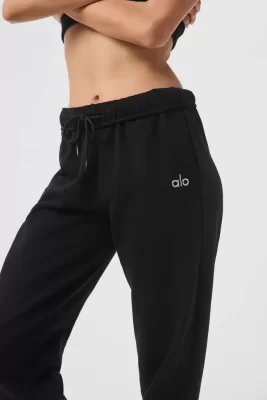
Après avoir examiné de près les matériaux d'Alo dans le cadre de notre analyse de fabrication concurrentielle, j'ai acquis un aperçu de ce qui rend leurs tissus uniques. Alo se distingue par des traitements de finition spécialisés et des structures de tricot particulières plutôt que par des compositions de matériaux radicalement différentes de celles des autres marques haut de gamme.
Les principales technologies de tissus d'Alo comprennent :
Technologies de tissu clés d'Alo
| Nom du tissu | Composition du matériau | Propriétés clés | Produits populaires |
|---|---|---|---|
| Aérographe | 87 % polyester, 13 % élasthanne | Finition lisse et mate, compression modérée | Legging aérographe taille haute |
| Transport aérien | 86 % nylon, 14 % élasthanne | Double maille micro-performante, sculptante | Legging Airlift taille haute |
| Alosoft | 87 % polyester, 13 % élasthanne | Texture douce et veloutée, légère | Legging de détente Alosoft |
| Vapeur | 77 % nylon, 23 % élasthanne | Léger, effet rafraîchissant, compression élevée | Legging Vapor taille haute |
| Rayures ensoleillées | 90 % polyester, 10 % élasthanne | Texture côtelée, compression modérée | Legging taille haute à rayures ensoleillées |
What distinguishes Alo's fabrics from competitor products using similar material ratios is their finishing processes. Their signature "Airbrush" le tissu subit un calandrage spécialisé (un processus de finition utilisant la chaleur et la pression) qui crée sa texture de surface lisse distinctive tout en conservant une élasticité dans 4 directions.
La teneur plus élevée en élasthanne (13-14 %) dans leurs tissus principaux offre une excellente récupération, bien qu'elle soit légèrement inférieure à celle de certains concurrents axés sur la performance qui utilisent jusqu'à 20 % d'élasthanne. Ce choix de composition reflète le positionnement d'Alo à l'intersection des vêtements de performance et de la mode : leurs pantalons offrent suffisamment d'élasticité pour la pratique du yoga tout en mettant l'accent sur une esthétique qui s'adapte bien au quotidien.
La saturation des couleurs d'Alo, en particulier dans ses nuances vibrantes, provient d'un processus de teinture spécialisé qui pénètre plus profondément dans les fibres de nylon que les méthodes standard. Cela contribue à la fois à la richesse de leurs couleurs et à une meilleure solidité des couleurs par rapport aux techniques de teinture plus basiques.
Pour les consommateurs qui tentent de choisir entre Alo et d’autres marques haut de gamme, la décision se résume souvent à des préférences d’ajustement et à des différences esthétiques plutôt qu’à des différences techniques dramatiques. Les matériaux d'Alo offrent généralement une sensation de main légèrement plus douce avec une compression modérée, par rapport à la compression plus prononcée trouvée dans certains produits concurrents.
De notre point de vue de fabrication, la qualité des matériaux d'Alo est comparable à celle d'autres marques haut de gamme, même si elles se sont taillé une niche distinctive grâce à leurs techniques de finition et à leur développement sophistiqué de couleurs. Pour les yogis qui recherchent un équilibre entre performance et style qui s'étend bien au-delà du studio, leurs technologies de tissus offrent une option convaincante.
Quel tissu est le meilleur pour le yoga ?
The "best" Le tissu pour pantalons de yoga peut varier considérablement en fonction du style de pratique, des préférences personnelles et du budget. De nombreux yogis se sentent désorientés par les allégations marketing et ont du mal à identifier quel matériau répondra réellement à leurs besoins.
Le meilleur tissu pour les pantalons de yoga dépend de votre pratique spécifique. Pour le yoga chaud ou le vinyasa de haute intensité, recherchez des mélanges synthétiques contenant au moins 15 % d'élasthanne de haute qualité (comme le Lycra®). Pour des pratiques plus douces, les mélanges nylon-spandex (75 à 85 % de nylon) offrent un confort supérieur. Les praticiens soucieux de leur budget devraient rechercher des mélanges polyester-élasthanne contenant au moins 20 % d'élasthanne pour une récupération adéquate.
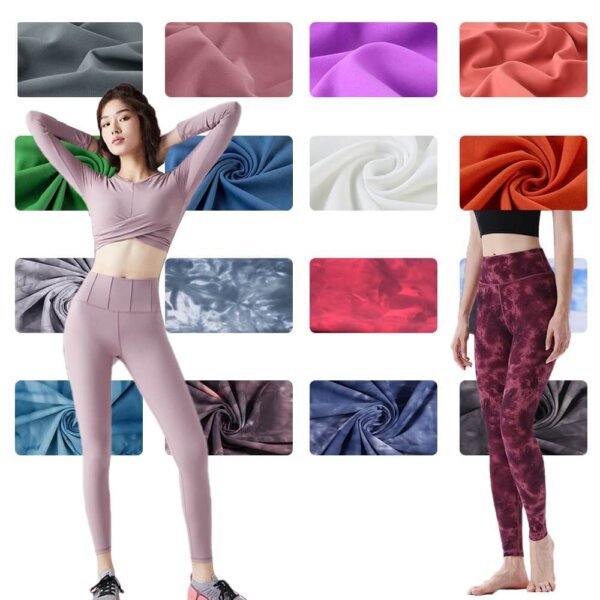
From my experience manufacturing for various yoga brands, I've found that the "best" le tissu varie considérablement en fonction de facteurs allant au-delà du simple style de yoga. Le type de corps, le climat, la régulation personnelle de la température et même les habitudes de lessive peuvent avoir un impact sur le matériau le plus performant pour un individu.
Lorsque nous aidons les marques à développer leurs formulations de tissus idéales, nous prenons en compte plusieurs dimensions de performance :
Facteurs de performance clés dans les tissus des pantalons de yoga
| Facteur de performance | Meilleure option matérielle | Pourquoi ça compte |
|---|---|---|
| Gestion de l'humidité | Polyester-élasthanne avec finition absorbant la transpiration | Empêche l'accumulation de sueur et les frottements pendant la pratique |
| Confort/sensation douce | Nylon-spandex ou polyester-spandex avec intérieur brossé | Améliore la concentration en éliminant les distractions du tissu |
| Opacité/non transparent | Tricot de polyester ou de nylon haute densité extensible dans 4 directions | Fournit la confiance pendant les poses de flexion et d’étirement |
| Durabilité/Longévité | Mélange de Nylon-Lycra® avec au moins 15 % de Lycra | Garantit que le pantalon maintient ses performances grâce à une pratique régulière |
| Compression/Soutien | Mélanges à haute teneur en spandex (20-30 %) | Fournit un soutien musculaire et une amélioration de la forme |
| Respirabilité | Tricots en polyester à structure ouverte ou mélanges de fibres naturelles | Maintient une température corporelle confortable pendant la pratique |
Sur la base de notre expérience en matière de fabrication et des commentaires de nos clients, je recommanderais ces types de tissus spécifiques pour différentes pratiques de yoga :
Pour le yoga chaud : recherchez des mélanges polyester-élasthanne haute performance (80 %/20 %) avec des capacités d'évacuation de l'humidité améliorées. Ces matériaux évacuent l'humidité de la peau et sèchent rapidement, évitant ainsi la sensation de lourdeur et de détrempage qui peut survenir lors de séances de transpiration intense. Certains matériaux plus récents intègrent des technologies de refroidissement comme le jade ou des particules de céramique intégrées dans la fibre pour améliorer cet effet.
Pour le Vinyasa ou le Power Yoga : les mélanges nylon-spandex dans la gamme 75-85 % nylon offrent un équilibre idéal entre étirement, récupération et durabilité pour le mouvement constant dans ces pratiques. La légère compression fournie par ces tissus peut également améliorer la proprioception (conscience de la position du corps), que de nombreux praticiens trouvent utile pour maintenir l'alignement.
Pour un yoga doux ou réparateur : des tissus brossés plus doux avec du modal ou du coton mélangé à des matières synthétiques offrent le confort nécessaire pour des poses plus longues. La gestion de l'humidité étant moins cruciale, un pourcentage plus élevé de fibres naturelles (jusqu'à 50 %) peut être incorporé sans compromettre les performances.
For Everyday Wear: "Performance cotton" les mélanges combinant coton, polyester et élasthanne offrent le confort décontracté du coton avec une durabilité et une rétention de forme améliorées. Ces tissus fonctionnent bien pour ceux qui portent leur pantalon de yoga au-delà de la pratique.
La qualité du composant spandex/élasthanne ne peut être surestimée. Dans notre production, nous proposons des options de spandex standard et de Lycra® haut de gamme, ces dernières coûtant beaucoup plus cher mais offrant une bien meilleure récupération d'étirement tout au long du cycle de vie du vêtement. Pour les pantalons que vous prévoyez de porter fréquemment, cette mise à niveau vaut presque toujours l’investissement.
Les leggings en coton pillent-ils ?
Le boulochage est une préoccupation courante lorsque l’on investit dans des pantalons de yoga, car ces boules de tissu disgracieuses peuvent rapidement donner un aspect usé à des leggings coûteux. La teneur en coton étant souvent accusée de boulochage, de nombreux consommateurs se demandent s'ils devraient l'éviter complètement.
Oui, les leggings en coton boulochent généralement plus facilement que les alternatives synthétiques. Les fibres de coton les plus courtes ont tendance à se détacher de la surface du tissu pendant le port et le lavage, formant ainsi des boules ou des bouloches caractéristiques. Les leggings en coton mélangé contenant moins de 50 % de coton et des structures tricotées plus serrées pilulent beaucoup moins que les options à haute teneur en coton.
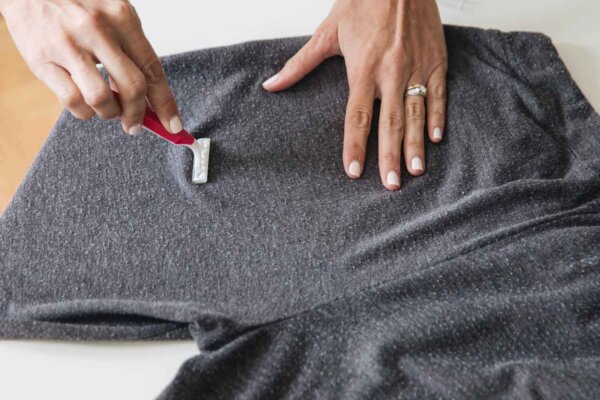
D'après notre expérience en matière de fabrication, le boulochage est l'une des plaintes les plus courantes des clients concernant les pantalons de yoga, en particulier ceux contenant du coton. La science derrière cela est simple : les fibres de coton sont plus courtes que les alternatives synthétiques comme le polyester ou le nylon, ce qui les rend plus susceptibles de se détacher du fil et de former des bouloches à la surface.
Lors du développement de tissus pour des clients soucieux de la résistance au boulochage, nous nous concentrons sur plusieurs facteurs clés :
Facteurs affectant le boulochage dans les pantalons de yoga
| Facteur | Impact sur le boulochage | Meilleure pratique |
|---|---|---|
| Longueur de fibre | Les fibres plus courtes (comme le coton) pilulent plus facilement | Utilisez du coton à fibres longues si vous utilisez du coton, ou optez pour des synthétiques à filaments continus |
| Étanchéité du tricot | Les tricots plus amples permettent plus de mouvement des fibres et de boulochage | Choisissez des structures à haute densité et en tricot serré |
| Rapport de mélange de fibres | Un pourcentage de coton plus élevé augmente le risque de boulochage | Gardez le coton en dessous de 50 % dans les leggings de performance |
| Torsion de fil | Les fils à faible torsion boulochent plus facilement | Sélectionnez des tissus utilisant une construction de fils à haute torsion |
| Traitements de surfaces | Les finitions anti-boulochage peuvent réduire le boulochage | Recherchez des leggings avec traitement anti-bouloche |
Les zones à forte friction sont particulièrement sensibles au boulochage, c'est pourquoi les leggings en coton développent souvent des bouloches d'abord entre les cuisses, autour des genoux ou dans les zones où le tissu frotte contre d'autres surfaces. Cette friction tire efficacement les fibres courtes de coton vers la surface où elles s'emmêlent et forment les boules caractéristiques.
Dans notre usine de production, nous effectuons des tests de boulochage standardisés en utilisant la méthode Martindale, où les tissus sont frottés contre un tissu abrasif en laine pendant des milliers de cycles pour simuler l'usure. Les tissus à forte teneur en coton commencent généralement à présenter des bouloches après seulement 5 000 à 10 000 cycles, tandis que les tissus synthétiques de haute qualité peuvent présenter un boulochage minime même après plus de 20 000 cycles.
Pour les consommateurs qui préfèrent la sensation du coton mais souhaitent minimiser le boulochage, je recommande de rechercher des mélanges présentant ces caractéristiques :
- Teneur synthétique plus élevée (au moins 50 % de polyester ou de nylon)
- Structures tricotées plus serrées et plus denses qui maintiennent les fibres plus solidement
- Finitions anti-bouloches (même si celles-ci disparaîtront progressivement)
- Variétés de coton à fibres longues si une teneur plus élevée en coton est souhaitée
La façon dont vous entretenez les leggings en coton mélangé a également un impact significatif sur le boulochage. Les retourner avant le lavage, utiliser des cycles délicats, éviter les assouplissants (qui peuvent affaiblir les fibres) et sécher à l'air plutôt que d'utiliser un sèche-linge peuvent tous contribuer à prolonger la durée de vie des leggings en coton et à réduire le boulochage.
Pour les pratiquants de yoga qui utilisent beaucoup leurs leggings, la réalité est que le coton pur ou les mélanges à haute teneur en coton piluleront presque inévitablement plus rapidement que les alternatives synthétiques. C’est l’une des raisons pour lesquelles la plupart des marques de yoga axées sur la performance ont complètement abandonné le coton dans leurs leggings techniques.
Le boulochage est-il synonyme de mauvaise qualité ?
Lorsque vous remarquez la formation de petites boules frustrantes sur votre pantalon de yoga coûteux, il est naturel de vous demander si vous avez acheté un produit de mauvaise qualité. La relation entre le boulochage et la qualité n’est pas toujours simple.
Le boulochage n’indique pas automatiquement une mauvaise qualité, bien qu’un boulochage excessif ou précoce le soit souvent. Même les tissus haut de gamme peuvent pelucher dans certaines conditions. Les facteurs de qualité incluent la rapidité avec laquelle le boulochage commence, l'ampleur du boulochage et la façon dont le tissu se comporte dans d'autres aspects tels que la récupération d'étirement et la rétention de la couleur.
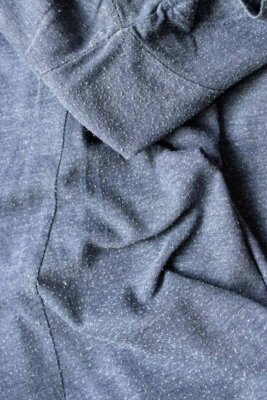
Au cours de mes années de fabrication de vêtements de sport, j'ai vu des produits budgétaires et de luxe développer des pilules. La différence ne réside généralement pas dans la question de savoir si le pilling se produit mais dans le début et à quel point il se développe.
Lorsque nous développons des tissus pour différents segments de marché, nous ajustons plusieurs facteurs qui influencent la résistance aux piles tout en maintenant les prix cibles:
Indicateurs de qualité liés au boulochage dans les pantalons de yoga
| Indicateur de qualité | Produits économiques | Produits de milieu de gamme | Produits premium |
|---|---|---|---|
| Temps pour les premières pilules | 1-5 us / lavages | 10-20 us / lavages | 30+ us / lavages |
| Qualité des fibres | Fibres plus courtes, contenu recyclé | Mélange de qualités de fibres | Filaments à long terme ou continu |
| Densité tricotée | GSM inférieur, construction plus lâche | Densité moyenne | Structures de haute densité et d'ingénierie |
| Traitements anti-pichets | Aucun ou basique | Traitements standard | Traitements durables avancés |
| Technologie de fil | Fils tournés de base | Touche ou texturation améliorée | Fils d'ingénierie, microfilament |
Les pantalons de yoga premium utilisent généralement des matières premières de meilleure qualité et des processus de fabrication plus sophistiqués pour retarder et minimiser les pilules. Dans nos gammes de produits premium, nous utilisons souvent des fibres de polyester à filament continu ou de nylon plutôt que des fibres filées. Ces brins continus plus longs sont beaucoup plus résistants au travail en vrac à partir de la surface du tissu.
La méthode de construction a également un impact significatif sur la résistance aux pilules. Les machines à tricot circulaire peuvent être réglées sur différentes jauges (aiguilles par pouce), avec des jauges plus élevées créant des tricots plus denses plus denses qui sécurisent mieux les fibres et réduisent les pilules. Les produits Premium utilisent généralement des machines de calibre 28 ou supérieures, tandis que les produits économiques peuvent utiliser une calibre 24 ou moins.
Cependant, même les tissus de la plus haute qualité peuvent éventuellement piluler dans certaines conditions. Les activités à forte friction, le lavage répété et le contact avec des surfaces plus rugueuses peuvent provoquer un piletage même dans des produits premium. La différence est que les tissus de meilleure qualité résisteront à ce processus beaucoup plus longtemps et ne peuvent piluler que dans des zones limitées plutôt que dans l'ensemble du vêtement.
Pour les consommateurs évaluant la qualité, il est important de considérer le boulochage dans le contexte d’autres aspects de la performance :
-
Si les leggings pilules après seulement 1 à 2 utilisations mais fonctionnent bien, cela indique probablement une faible résistance au boulochage mais pas nécessairement une mauvaise qualité globale.
-
Si les leggings pilules après un port minimal ET présentent d'autres problèmes comme des ceintures étirées ou une décoloration, cela suggère des problèmes de qualité complets.
-
Si les leggings développent un minimum de boulochage uniquement dans les zones à forte friction après de nombreux usages et lavages, cela est normal, même pour les produits haut de gamme.
Lorsque nous effectuons des tests d'usure pour les nouveaux tissus, nous nous attendons à ce que même des produits haut de gamme montrent des pilulations après des usures de 25-30 et des lavages dans des zones à haute friction. Cependant, ces pilules doivent être relativement faibles, peu nombreuses, et principalement concentrées dans des zones d'abrasion maximale comme les cuisses intérieures.
Est-il acceptable de s'entraîner avec des leggings en coton ?
De nombreux praticiens de yoga possèdent des leggings en coton et se demandent s'ils sont adaptés à leur pratique. Les options de synthèse dominant le marché, les leggings en coton deviennent souvent relégués aux vêtements de salon plutôt qu'aux vêtements de sport.
Bien que vous puissiez techniquement vous entraîner avec des leggings en coton, ils ne sont pas idéaux pour la plupart des styles de yoga. Le coton absorbe et retient l'humidité, devenant lourd et potentiellement inconfortable lors des pratiques qui transpirent. Pour du yoga doux ou une activité très légère à température modérée, les leggings en coton peuvent être acceptables, mais ils ne sont pas recommandés pour le yoga vigoureux ou chaud.
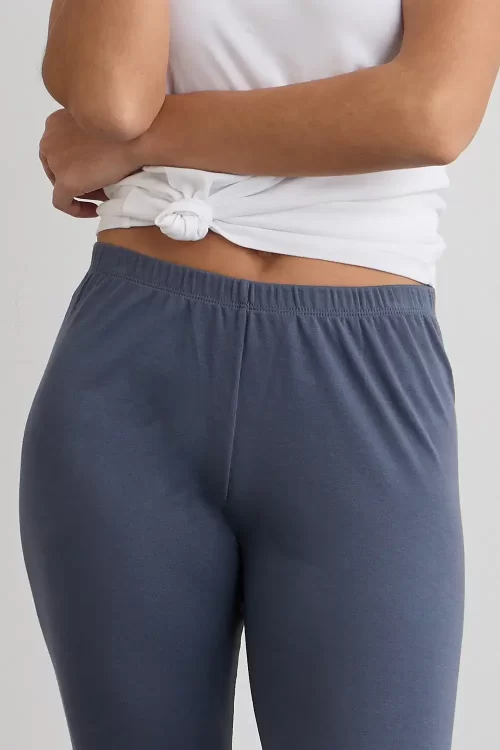
J'ai travaillé avec des studios qui testaient différents types de tissus pour différents styles de yoga, et le coton se classait systématiquement mal pour tout ce qui allait au-delà des pratiques les plus douces. Le principal problème est la gestion de l'humidité : la grande capacité d'absorption du coton devient problématique pendant l'exercice.
Voici comment les leggings en coton fonctionnent dans différents contextes de yoga :
Performance des leggings en coton par Yoga Style
| Yoga Style | Leggings en coton l'adéquation | Problèmes principaux | Meilleure alternative |
|---|---|---|---|
| Yoga chaud | Pauvre | Poids excessif lorsqu'il est humide, séchage lent, frottement potentiel | Mélanges en polyester-spandex avec finition en mèche |
| Vinyasa / Power Yoga | Pauvre à juste | Récupération d'étirement limitée, rétention de la transpiration | Mélanges en nylon-spandex (80/20) |
| Hatha yoga | Équitable | Limitations d'étirement modérées, quelques problèmes d'humidité | Mélanges de coton-synthétique (max à 50% de coton) |
| Yin / réparateur | Bien | Limitations d'étirement mineures | Mélanges de coton ou tissus modaux |
| Méditation | Excellent | Aucun significatif | Tout tissu confortable |
Lors de la fabrication pour des clients ciblant différents marchés du yoga, nous ajustons nos recommandations de tissus en fonction du niveau d'intensité attendu. Pour les marques de yoga chaud, nous déconseillons fortement toute teneur en coton, tandis que pour les marques de style de vie ou de yoga doux, nous pouvons inclure jusqu'à 50 % de coton dans les tissus mélangés.
La science derrière la mauvaise performance du coton dans des contextes actifs est simple. Le coton a une valeur de récupération d'humidité élevée (il peut retenir 24 à 27 % de son poids en humidité), ce qui signifie qu'il absorbe facilement la transpiration. Contrairement aux fibres synthétiques, il n'évacue pas efficacement cette humidité vers la surface pour l'évaporation, de sorte que le tissu reste humide, lourd et potentiellement irritant pour la peau.
Au-delà de la gestion de l’humidité, les leggings en coton posent plusieurs autres défis pour la pratique du yoga :
-
Problèmes d'opacité : Lorsqu'il est mouillé, le coton devient plus transparent, créant potentiellement des situations embarrassantes lors de la pratique.
-
Distorsion de forme : Le coton s'étire lorsqu'il est mouillé et ne récupère pas bien, ce qui entraîne des genoux et des sièges amples après une activité modérée.
-
Risque de frottement : Le coton mouillé peut créer une friction contre la peau, provoquant potentiellement une irritation lors de mouvements répétitifs
-
Froid lorsqu'il est mouillé : Le coton mouillé perd ses propriétés isolantes, ce qui peut entraîner un refroidissement inconfortable lorsque la sueur refroidit
Si vous choisissez d'utiliser des leggings en coton pour vos entraînements, recherchez ceux qui présentent :
- Teneur en coton inférieure (idéalement 50 % ou moins)
- Ajout de spandex (au moins 5%) pour l'étirement et la récupération
- Des modèles de tricot plus serrés et plus structurés
- Traitements pré-rétrécis pour minimiser le changement de forme après le lavage
Pour la plupart des pratiquants, les synthétiques performants ou les mélanges soigneusement conçus offriront une expérience bien meilleure que les leggings en coton lors de pratiques de yoga actives. L'exception pourrait être les formes de yoga très douces où les mouvements et la transpiration sont minimes, ou les pratiquants ayant des sensibilités cutanées spécifiques qui trouvent les tissus synthétiques irritants.
Comment puis-je empêcher mes leggings de boulocher ?
Le boulochage peut rapidement transformer votre pantalon de yoga préféré d'élégant à défraîchi. Avec l'investissement important que de nombreux yogis font dans des leggings de qualité, la prévention et la gestion du boulochage deviennent une considération importante.
Pour éviter que les leggings ne boulochent, lavez-les à l’envers au cycle délicat à l’eau froide et évitez les assouplissants. Séchez à l’air plutôt que d’utiliser un sèche-linge. Réduisez la friction externe en évitant les surfaces rugueuses et en ne portant pas de leggings sous des vêtements rugueux. Pour les pilules existantes, retirez-les soigneusement avec un rasoir à tissu ou un peigne à pull.
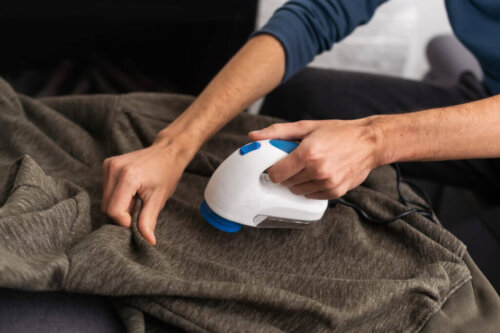
Tout au long de mes années dans la fabrication de vêtements, j'ai fourni des instructions d'entretien à de nombreux clients cherchant à aider leurs clients à prolonger la durée de vie de leurs pantalons de yoga. Même si certains boulochages peuvent être inévitables avec le temps, ces techniques peuvent retarder et minimiser considérablement le problème.
Les stratégies anti-boulochage les plus efficaces peuvent être divisées en plusieurs catégories :
Entretien complet des leggings pour éviter le boulochage
| Catégorie de soins | Technique | Pourquoi ça marche |
|---|---|---|
| Techniques de lavage | Retourner avant de laver | Réduit l’abrasion sur la surface extérieure visible |
| Utiliser un cycle doux avec de l'eau froide | Minimise l'agitation qui peut détacher les fibres | |
| Passer les assouplissants | Les adoucissants affaiblissent les fibres, les rendant plus susceptibles de se briser et de boulocher | |
| Utilisez des sacs à linge en filet | Réduit le contact avec d'autres vêtements pendant le lavage | |
| Méthodes de séchage | Sécher à l'air libre à plat ou suspendu | Élimine l'action de culbutage qui provoque la friction |
| Si vous utilisez un sèche-linge, utilisez un feu doux | Une chaleur élevée peut affaiblir les fibres élastiques et augmenter le boulochage | |
| Habitudes de port | Évitez les surfaces rugueuses (velcro, bois brut) | Réduit l’abrasion externe qui détache les fibres |
| Ne pas superposer sous des tissus rugueux | Empêche le frottement constant contre la surface des leggings | |
| Faire pivoter plusieurs paires | Permet au tissu de récupérer entre les utilisations | |
| Retrait des pilules | Utilisez un rasoir à tissu | Élimine les pilules en toute sécurité sans endommager le tissu |
| Essayez un peigne à pull | Élimine en douceur les pilules des tissus délicats | |
| Retirer les pilules une fois sèches | Le tissu mouillé est plus susceptible d'être endommagé |
Dans notre centre de tests, nous avons constaté qu'une bonne technique de lavage fait la différence la plus significative en matière de prévention du boulochage. De nombreux consommateurs ne réalisent pas que l'agitation des cycles de lavage standard recrée essentiellement la friction qui provoque le boulochage lors de l'usure. En utilisant des cycles doux et de l'eau froide, vous réduisez considérablement cette action néfaste.
Pour les leggings que vous possédez déjà et qui ont commencé à piluler, un retrait soigneux des pilules peut revitaliser leur apparence. Je recommande des rasoirs dédiés aux tissus plutôt que des rasoirs jetables (ce que certains suggèrent en ligne) car ils sont conçus avec une profondeur de lame appropriée pour éliminer les pilules sans endommager le tissu sous-jacent. Lorsque vous utilisez un outil pour retirer les pilules, travaillez dans une direction avec une légère pression plutôt que de frotter d'avant en arrière.
Les traitements préventifs sont une autre option à considérer. Plusieurs traitements commerciaux pour tissus prétendent réduire le boulochage, bien que leur efficacité varie. D'après notre expérience en matière de fabrication, les traitements par lavage ont tendance à perdre de leur efficacité après 5 à 10 lavages, tandis que les traitements par pulvérisation peuvent laisser des résidus qui affectent le toucher du tissu.
L'approche à long terme la plus efficace combine des achats réfléchis avec des soins appropriés. Lors de la sélection de nouveaux leggings, examinez ces facteurs pour identifier les options résistantes aux pilules:
- Composition de tissu - Recherchez des filaments synthétiques continus plutôt que des fils filés
- Densité du tissu - Les tissus à GSM (grammes par mètre carré) plus élevé avec des tricots serrés résistent généralement mieux au boulochage
- Qualité de construction - Examiner les coutures et la construction globale ; une fabrication de qualité est souvent en corrélation avec des matériaux de qualité
- Réputation de la marque - Recherchez si d'autres clients signalent un boulochage précoce avec cette marque
Pour les yogis qui pratiquent fréquemment, je recommande fortement d'investir dans plusieurs paires de leggings de qualité plutôt qu'une seule paire coûteuse. Cette approche de rotation prolonge non seulement la durée de vie de chaque paire en réduisant la fréquence de lavage, mais permet plus de temps de récupération entre les usures, ce qui peut aider les composants élastiques à maintenir leur résilience.
Conclusion
La sélection du bon pantalon de yoga consiste à comprendre l'interaction complexe entre la composition, la construction et les soins du tissu. Que vous soyez attiré par les innovations techniques de Lululemon, l'attrait esthétique d'Alo Yoga ou que vous essayez de faire durer plus d'options pour le budget, la clé correspond à votre sélection à vos besoins de pratique spécifiques.
Alors que les tissus synthétiques surpassent généralement le coton pour les styles de yoga actifs, des techniques d'entretien appropriées peuvent prolonger la durée de vie de n'importe quel pantalon de yoga. En comprenant les causes du boulochage et comment l'éviter, vous pouvez maintenir vos leggings préférés en meilleur état pendant de plus longues périodes, rentabilisant ainsi votre investissement.
Obtenez un devis gratuit pour vos projets de vêtements de yoga
